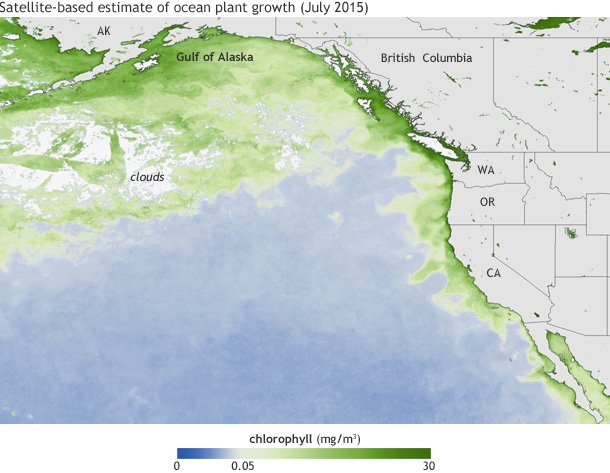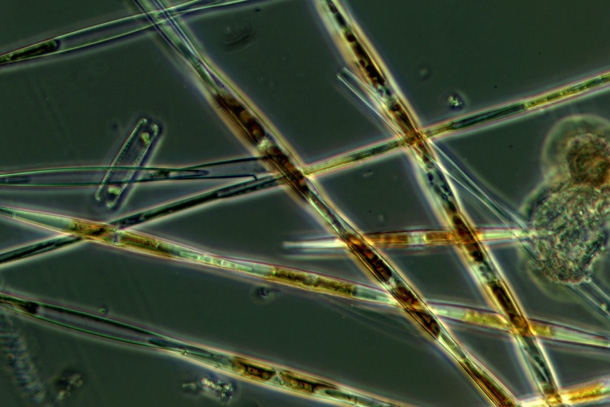A Massive Algae Bloom is Wreaking Havoc On the West Coast
By:
Since May, a giant, poisonous algae bloom has been steadily growing along the Pacific coastline, stretching from California to Alaska, affecting both sport and commercial fisheries along the coast, and leeching its way into the food web, according to news reports. The bloom is estimated to be some 40 miles wide and dip 650 feet into the Pacific Ocean.
 Climate.Gov - climate.gov
Climate.Gov - climate.gov
Algae blooms are normal occurrences, but scientists fear that this year's massive Pacific bloom—already the largest on record—could be indicative of future blooms as the climate warms and water temperatures rise, providing ideal habitats for harmful species of algae to produce toxins that can be deadly for humans and other sea life. (There is also currently a toxic bloom in Lake Erie, as there was in the summer of 2014.)
Floating throughout the Pacific bloom is a species of algae known as pseudo-nitzchia that produces a neurotoxin called domoic acid. And even though the substance is naturally occurring, its levels spike in small fish and shellfish during an algal bloom, Scientific American reports. But with the current bloom covering such a vast area, more and more predators of shellfish and small fish risk exposure to domoic acid, which reports say can lead to a litany of negative side effects for human consumers, including, in severe cases, seizures, memory loss, and even death. Already in Washington, Oregon and California, local officials have shuttered lucrative fisheries and placed moratoriums on recreational harvests of shellfish in some areas, Al Jazeera notes.
 Climate.Gov - climate.gov
Climate.Gov - climate.gov
Typically, algae blooms crop up in warmer water, like during naturally occurring El Nino formations and last for only a short time. But theories as to the size and longevity of the Pacific bloom point to factors that some say will only get worse in the coming years, paving the way for bigger and longer blooms—and all of the negative health and economic side effects that come with them.
One theory posits that unusually high temperatures in the northeast Pacific during the winter of 2013-2014 set off what scientists refer to as "the blob," a patch of warm water that has provided a breeding ground for harmful algae which subsequently has made its way to coastal areas along the Western U.S. And if natural spikes in water temperatures (think El Nino) occur on top of already warmer waters, toxin-producing algae could gain a sturdy foothold in such sustainable conditions.
"The connection with climate change is that these are the sorts of conditions we would expect with a warming ocean," Raphael Kudela, ocean sciences professor at the University of California Santa Cruz told VICE News. "It's always difficult to attribute any one event to climate change, but it is certainly consistent with what we expect to happen," he said, adding that the Pacific bloom was already the largest and longest-lasting bloom of the past 15 years, containing some of the highest concentrations of toxins to be measured.
Another theory places blame on high levels of fertilizer used in the midst of a ravaging drought on the West Coast, in conjunction with erratic rainfall in April and May that caused nutrient-rich runoff to seep into the ocean and boost the algae's chances of surviving and flourishing in the warm waters there, according to VICE News.
According to the National Oceanic Atmospheric Administration numbers, harmful algae blooms cost an estimated $82 million in economic losses each year, and threats to coastal states' economies are already materializing with closed fisheries and prohibited recreational harvesting. But longer and more expansive blooms threaten to have a greater impact on communities there, whose economies often have a substantial stake in seafood-related tourism and exports. In Washington state, for example, where a large Dungeness crab fishery was closed in June. Crabbing is an $84 million industry, according to NOAA, which granted nearly $90,000 to the state last month to monitor and analyze the Pacific bloom.
